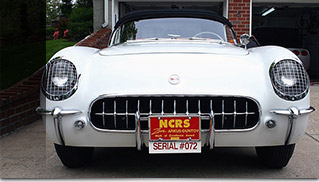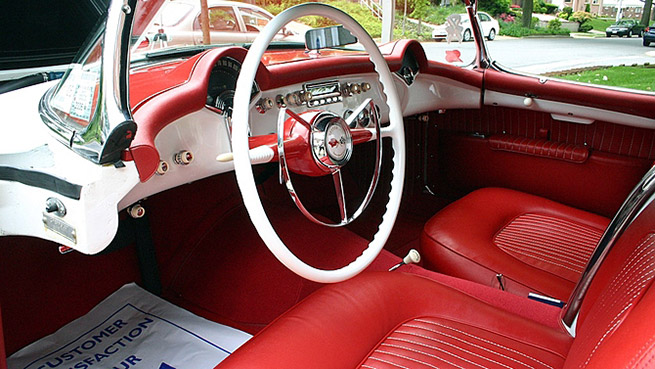 150 bhp, 235.5 cu. in. “Blue Flame” OHV inline six-cylinder engine, three 1-barrel Carter carburetors, Powerglide two-speed automatic transmission, independent front suspension with unequal length A-arms and coil springs, live rear axle with semi-elliptic leaf springs, and four-wheel hydraulic drum brakes. Wheelbase: 102 in.
150 bhp, 235.5 cu. in. “Blue Flame” OHV inline six-cylinder engine, three 1-barrel Carter carburetors, Powerglide two-speed automatic transmission, independent front suspension with unequal length A-arms and coil springs, live rear axle with semi-elliptic leaf springs, and four-wheel hydraulic drum brakes. Wheelbase: 102 in.
In the early-1950s, a team of GM engineers, headed up by Harley Earl, went to work trying to create a fiberglass-bodied car that had the appeal to compete with European sports cars. Harley Earl had excelled at swooping design since the 1920s and designed aircraft-looking features into the car, including round dials blended into a curved dash, all of which was sheltered under a roofline that stood just under 47 inches tall. The six-cylinder engine was positioned farther toward the rear, which gave the flat hood a long sleek appearance. By the time it was ready to be unveiled, it is reported that GM had spent over $1.5 million on the project.
Dubbed the Corvette “Dream Car,” it debuted at the GM Motorama show held at the stylish Waldorf-Astoria Hotel in New York City with astounding results. Following the first weekend of the Motorama event in New York, over 300,000 people had seen the car and spent $800,000 on GM products. Concluding Motorama’s U.S. tour, GM stated that over four million people had seen the car.

Production of the two-seat roadster started in June 1953, and by year’s end, a total of only 300 Corvettes rolled off the assembly line. This first year of Corvette production signified an important technical milestone: GM was the first major American car manufacturer to successfully mass-produce a vehicle whose underpan and bodyshell was made entirely of fiberglass.
The Corvette featured GM’s “Blue Flame” inline six, 235-cubic inch engine, with triple Carter carburetors and dual exhaust. The engine’s respectable 150 horsepower was transmitted to the road via a two-speed Powerglide automatic transmission. All 300 cars built in 1953 were visually identical, finished in Polo White with a Sportsman Red interior. The car was fitted with subtle pieces of chrome trim, which ran along either side, as well as wire meshing covering the headlights.
Source: Chevrolet